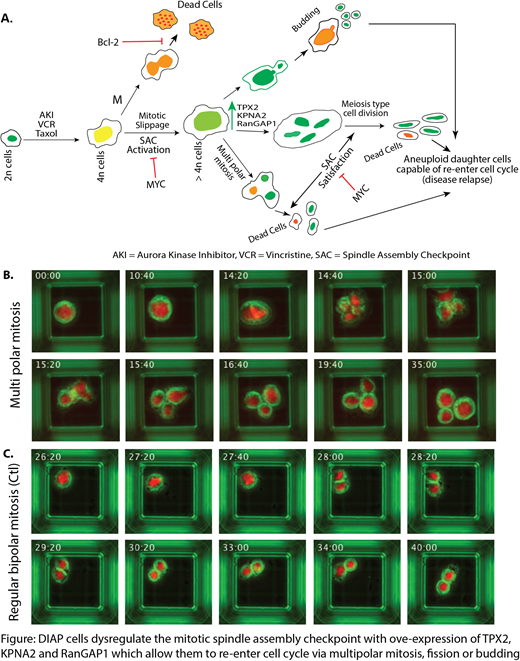Abstract
Key Points
MYC mediated upregulation of TPX2, KPNA2 and RanGAP1 dysregulate the spindle assembly checkpoint in drug-induced polyploid cells.
Drug-induced polyploid cells re-enter cell cycle via multipolar mitosis, fission or budding, a mechanism of disease relapse.
Abstract
Double-hit (DH) or double-expresser (DE) diffuse large B-cell lymphomas (DLBCL) are high-grade B-cell lymphomas that are mostly incurable with standard chemo-immunotherapy due to treatment resistance. The generation of drug-induced aneuploid/polyploid (DIAP) cells is a common effect of anti-DLBCL therapies (e.g. vincristine, doxorubicin). DIAP cells are thought to be responsible for treatment resistance, as they are capable of re-entering the cell cycle during off-therapy periods. Previously (DOI: 10.1158/1535-7163.MCT-17-0089) we demonstrated that combination of alisertib plus ibrutinib plus rituximab can partially abrogate DIAP cells and induce cell death. Here, we provide evidence that DIAP cells can re-enter the cell cycle and escape apoptosis during anti-DLBCL treatment. We also discuss MYC/BCL2 mediated molecular mechanisms that underlie treatment resistance. We isolated aneuploid/polyploid populations (2n-similar, 4n and 8n) of DH/DE-DLBCL cells after treatment with the aurora kinase (AK) inhibitor alisertib. Time-lapse microscopy of single polyploid cells (8n) revealed that following drug removal, these cells divide and proliferate by reductive cell divisions, including multipolar mitosis, meiosis-like nuclear fission and budding. Genomic, proteomic, and kinomic profiling of DIAP cells demonstrated up-regulation DNA damage, DNA replication and immune evasion pathways. In addition, the immune-kinome, AKT/MTorc1/2, and ERK/MAPK pathway are over-represented in 8n cells. Further, MYC-mediates dysregulation of the spindle assembly checkpoints by over-expression of RanGAP1, TPX2 and KPNA2. Multiple mechanisms contribute to DIAP which are amenable to novel therapeutic intervention(s) in MYC/BCL2-addicted high-grade B-cell lymphomas.
No relevant conflicts of interest to declare.
Author notes
Asterisk with author names denotes non-ASH members.


This feature is available to Subscribers Only
Sign In or Create an Account Close Modal